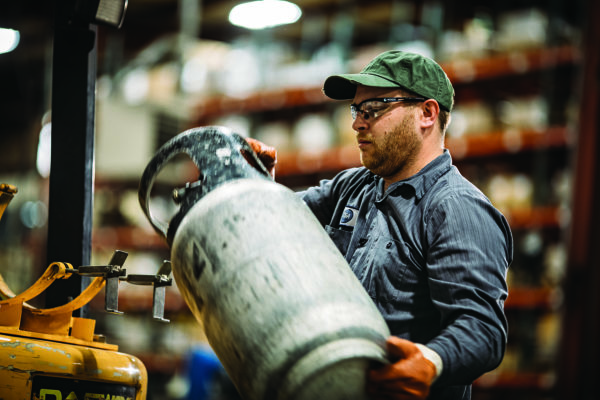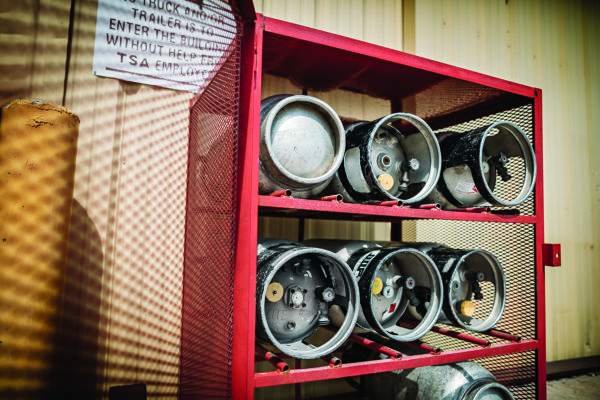Despite the growing trend towards electrification, propane continues to keep pace in the material handling space thanks to its reliable reputation, clean performance, and easy refueling.
In fact, 90 percent of Class 4 and 5 internal combustion engine forklifts are currently being powered by propane. The majority of fleet managers in the middle and top forklift weight classes prefer propane over electric and diesel, according to a survey from PERC (Propane Education & Research Council).
Propane cylinders are constructed to U.S. Department of Transportation and National Fire Protection Association standards for quality and contain safety features, like pressure relief valves, making them safe and easy to use. Because propane is a widely used forklift fuel across the country, it’s important for forklift operators to be in the know on cylinder safety and handling practices.
Cylinder Handling
 Following these general guidelines when handling propane cylinders will help ensure safe and efficient operation.
Following these general guidelines when handling propane cylinders will help ensure safe and efficient operation.
- Wear an approved protective glove and eye protection.
- Keep open heat, flames, and ignition sources away from cylinders and refueling equipment at all times.
- Handle cylinders carefully, making sure not to drop, throw, or drag them.
- Use proper lifting techniques when lifting cylinders
For even more convenient handling, forklift operators can ask their local propane supplier about the use of composite cylinders—a lightweight alternative to traditional steel tanks.
Refueling
Propane offers a quick, safe refueling process that requires no additional infrastructure or charging needs, like with electric equipment. For forklift operators of propane-powered forklifts, refueling is as simple as swapping out an empty cylinder for a full one.
Tips when removing a propane cylinder from equipment
- Shut the gas off by turning the cylinder service valve until tight (clockwise).
- Disconnect the gas line by unscrewing the service connection (counterclockwise).
- A small amount of gas may be released from the gas line upon disconnection, which is normal and doesn’t pose a safety hazard to employees.
- Release the brackets that hold the propane cylinder.
- Remove the empty forklift cylinder by using safe lifting practices.
- Store the empty cylinder in its designated storage area. Make sure to store with the relief valve at the highest point.
Tips when installing a propane cylinder on equipment
- Inspect the cylinder for any damage.
- If damaged, remove the cylinder from service and notify the local propane supplier on their next refueling stop. In the meantime, tag or mark the cylinder so it’s not used again.
- Ensure the main service valve on the full cylinder is all the way off.
- Use safe lifting practices to place the full cylinder on the forklift.
- The cylinder should be centered in the brackets and in alignment with the alignment pin (with the pressure relief valve at the 12 o’clock position).
- Once it’s properly situated, secure the cylinder by tightening the brackets. Make sure the straps are secure before operating.
- Connect the gas line to the service connection and tighten firmly (clockwise).
- Slowly turn the main service valve on (counterclockwise).
- Check for leaks. Forklift operators can check for leaks by spraying a solution (one-part soap, one-part water) over the tank connections.
- If employees notice bubbling or smell any gas, they should turn the valve off and re-check the connection and O-rings.
Depending on which refueling option businesses choose, propane suppliers can teach crews how to refill cylinders themselves (on-site refueling) or can refill cylinders for them (cylinder exchange program). Additionally, employees can receive safety training from propane suppliers, including instructions on how to safely install propane cylinders on their equipment.
Maintenance
Each time cylinders are exchanged or refilled, propane suppliers inspect cylinders, remove damaged cylinders from service, and repair or replace leaky valves and O-rings on cylinders as needed.
Storage & Disposal
 Propane cylinders can last up to three times as long as the average forklift battery. If businesses purchase their propane cylinders, propane suppliers can assist in the disposal of propane cylinders when the time comes. Alternatively, if businesses don’t want to purchase cylinders and storage cases, they can normally lease them from a local propane supplier.
Propane cylinders can last up to three times as long as the average forklift battery. If businesses purchase their propane cylinders, propane suppliers can assist in the disposal of propane cylinders when the time comes. Alternatively, if businesses don’t want to purchase cylinders and storage cases, they can normally lease them from a local propane supplier.
Make sure to store propane cylinder storage racks are located a safe distance from heat or ignition sources and protected from exposure to the elements. If need be, local propane suppliers can offer guidance on the best location.
To learn more about forklift safety, visit Propane.com/SafetyFirst. Click here to find a local propane supplier.
About the Author
Matt McDonald is director of off-road business development for the Propane Education & Research Council. He can be reached at matt.mcdonald@propane.com.











